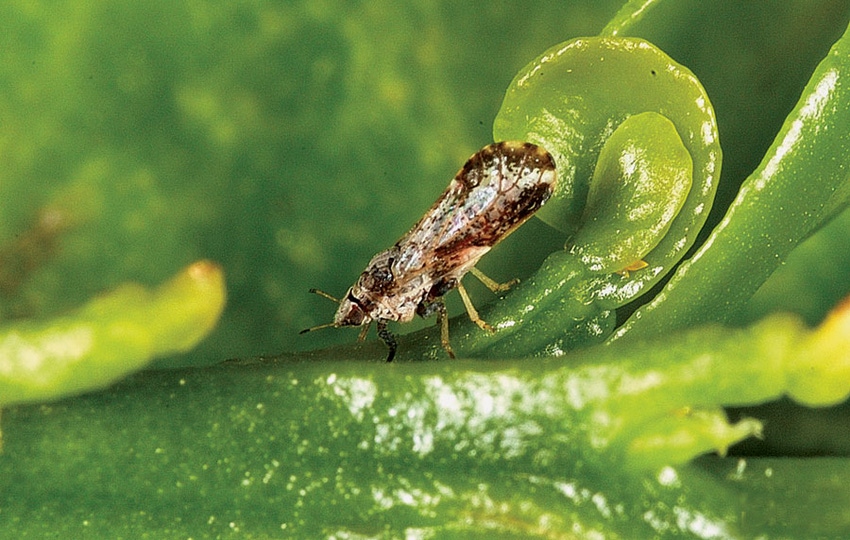
Industry marshaling forces to combat citrus greening disease threat
• The U.S. citrus industry is well aware that greening disease threatens more than 1 million commercial citrus acres with an annual production value of approximately $3 billion.• Estimates show yearly losses could reach $10 billion if citrus greening is left unchecked.

Aimed at eliminatingcitrus greeningby “blocking the ability of insects to move the disease from infected trees to healthy ones,” the USDA recently announced a $9 million grant to the Citrus Research and Development Foundation at Lake Alfred, Fla.
The U.S. citrus industry is well aware that greening disease threatens more than 1 million commercial citrus acres with an annual production value of approximately $3 billion. Estimates show yearly losses could reach $10 billion if citrus greening is left unchecked.
While Florida has a few years of experience with greening disease (also known as huanglongbing), the malady is still relatively new to Texas’ citrus industry.
After the discovery of nine orange trees with the disease, a five-mile quarantine area was quickly established last January.
What has happened since? Farm Press spoke with Ray Prewett of Texas Citrus Mutual and industry coordinator for industry response. Among Prewett’s comments:
The current citrus greening situation in Texas…
“We’ve got some positive developments and some new concerns. We’re very hopeful (citrus greening) isn’t widespread. However, there are some new indications that it is beyond where we originally thought. We’re concerned about what might unfold here in Texas in the next few months.
“It was found within two groves across the road from each other in San Juan, Texas. Since then, a lot of dooryard trees have been surveyed for the disease, as well as commercial groves. So far, the original two groves are still the only ones where we have found greening.
“A few weeks ago, we found a dooryard tree that tested positive, and last week we found another that tested positive. Those two trees are still within the five-mile quarantine zone that was set up around the first greening discovery.
“Texas Citrus Mutual has been working hard on psyllid control. We’ve tried to learn as much as we can from Florida’s experience, and have brought the psyllid population levels down some. There has been a bit of a spike of populations compared to last year — but that’s only spotty and in certain areas.”
Latency of the disease…
“One of the unfortunate things about greening disease is that a grove can be affected for several years before the symptoms show up.
Hard to run PCR test
If you can’t see the symptoms, for a variety of reasons, it’s very hard to run a PCR test and get a positive test on a tree. That might be because the disease is unevenly distributed in the tree, and if you sample in the wrong spot it won’t show a positive result.
“Regardless, the latency makes the disease hard to deal with.
“One of the things folks in Florida and California have advocated is actually testing the Asian citrus psyllids, the vector for the disease. For months we’ve followed their example and have been sampling tons of psyllids and had some positive hits.
“Based on the best estimates we have, there have been seven positive psyllids. Three of them were found within the five-mile quarantine and four were outside it. As we speak, we’re trying to figure out our next steps.”
The possibility of new quarantines/regulations…
“From a regulatory standpoint, the USDA, APHIS and the Texas Department of Agriculture don’t establish a new quarantine or take action based on positive psyllids. We must find the disease in tree tissue before regulatory action is taken.
“We’ve been speaking with scientists for whom we have high respect. I was speaking to one earlier today and it appears if you have a positive PCR sample from a psyllid, then that means you also have greening in plant tissue someplace. However, because of the latency issue and because it’s like finding a needle in a haystack, it’s hard to locate.
“So, the disease may have spread a bit in Texas. Even if that pans out, though, we’re optimistic that it hasn’t spread too far.
“For a variety of reasons — the positive psyllid finds and other things — the citrus industry has come together to say, ‘We need to ramp up all our efforts for psyllid control and everything related in dealing with this.’
Offers optimism
“That gives me optimism that we�’ll give it our best shot and slow it down. We know it’s unlikely we’ll ever get rid of the disease. But, we need to slow it down until the scientists come up with a practical answer to how to combat it.
“Unfortunately, there just isn’t too much in the scientific community right now that is terribly encouraging. There is a lot of effort going into a solution, but we’re still a long way from finding one.
“That solution may come in the form of a genetically-modified tree with resistance to greening. We support that — but it won’t happen for a while. And even if a GM tree was on our doorstep tomorrow, it wouldn’t help with the trees already producing. The technology would mean starting new groves and that would be an economic issue.”
More on current efforts to fight the disease…
“We’re doing a good job on psyllid control. We’re also doing what’s needed to protect nurseries, which is one of the quickest ways to have long-distance spread of the disease. We’re working on removing trees found to have innoculum.
“This disease is much worse on young trees than mature trees. Florida has spent a lot of money putting systemic pesticides on young trees — but that’s a tough battle. Younger trees are more susceptible, they go down quicker.
“We haven’t had a major freeze in Texas since 1989. Most of our trees are a pretty good size, so we’re a bit ahead on that count.”
The value of the Texas citrus industry…
“We’re small compared to Florida and California’s citrus industries. But we’re still talking about a $160 million to $200 million impact on the state.”
The $9 million recently allocated by the USDA for greening studies…
“Those funds will be managed by the foundation in Florida. My understanding is the first efforts will be to ‘build a better psyllid’ that won’t transmit the disease.
Part will be done in Texas
When the field testing part of that project is implemented, part of that will be done in Texas. I’m sure the same is true for California. All the citrus-growing states are involved.
“We’ve tried to learn from Florida’s experience and began psyllid control before the disease was discovered. That may have provided us with a head start.”
How the psyllids are tested…
“USDA/APHIS has a team of around 30 people who have been doing survey work here for the last three years. The first couple of years, that work was done exclusively in dooryards.
“It’s interesting that in the states where greening has shown up, it’s tended to first be found in dooryards.
“About a year ago, the team began taking samples from commercial groves in Texas. Our first incident was in a commercial grove.
“Since then, out of tens of thousands of psyllids being tested, all were negative for the disease until the last few months.
“All seven of the recent finds were from dooryards. That leads me to believe the dooryards are going to be a major part of the narrative.
“In Florida, there are a lot of areas where there aren’t too many dooryards interfaced with their commercial citrus. That isn’t true all over the state, but in many parts of the state groves are kind of isolated from housing developments.
“Unfortunately, that isn’t the case in Texas.
“We can’t prove that Texas’ greening problem came from Mexico for sure. But, greening is such a huge issue in Mexico that we have to believe that will be an ongoing threat.
Edge effect
“And there’s an ‘edge effect’ with this disease. The smaller your citrus blocks are, the more edge there is.
“Study after study shows that the primary spots you’ll first find both the psyllids and disease are at the grove’s edge — they don’t immediately head to the center of the grove. Since Texas has smaller blocks than Florida, that’s another challenge we face.”
Once an answer is found do you think there will be an effort by U.S. citrus to rid the country of this, like the cotton industry dealt with the boll weevil?
“Well, you don’t find a lot of cotton in people’s dooryards. It isn’t a dooryard plant.
“Citrus, on the other hand, is very much established in dooryards. I can’t tell you how many trailer parks we have down here. It isn’t unusual for a park to have 1,000 units. And in each of those units, there’s typically three to five trees in a small space. There are simply tons of trees in dooryards here.
“That’s why it would be very hard to deal with compared to the boll weevil — and that was hard enough.”
For more, see http://southeastfarmpress.com/orchard-crops/qa-harold-browning-chief-operating-officer-citrus-research-and-development-foundation and http://deltafarmpress.com/louisianas-citrus-industry-feels-threat-greening-disease
About the Author(s)
You May Also Like





